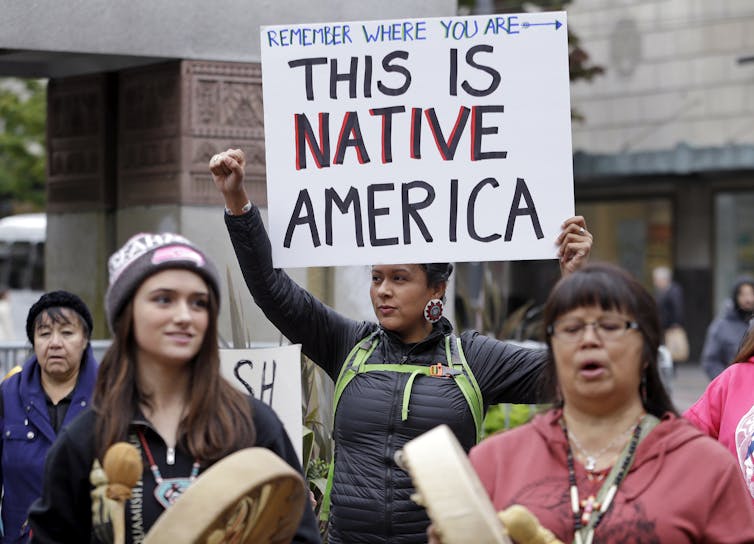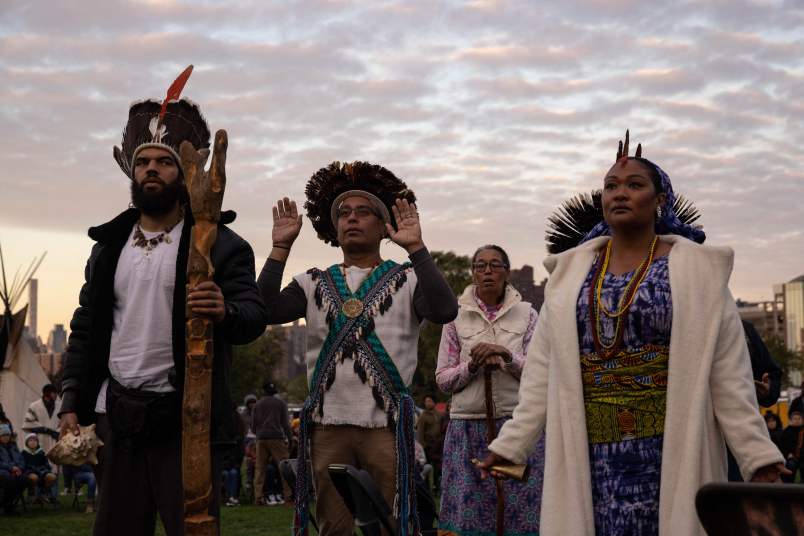This article is part of TPM Cafe, TPM’s home for opinion and news analysis. It was originally published at The Conversation.
Too often, K-12 social studies classes in the U.S. teach a mostly glossed-over story of U.S. settlement. Textbooks tell the stories of adventurous European explorers founding colonies in the “New World,” and stories of the “first Thanksgiving” frequently portray happy colonists and Native Americans feasting together. Accounts of the colonies’ battle for independence frame it as a righteous victory. Native American removal might be mentioned as a sad footnote, but the triumph of the pioneer spirit takes center stage.
As a scholar of Native American and Indigenous rhetorics, I argue that this superficial story hides the realities of what many historians and activists call “settler colonialism.” Historian Lorenzo Veracini asserts that colonial activity isn’t just about a nation sending out explorers and bringing back resources, or what scholars refer to as “classical colonialism.” It’s also about what happens when a new people moves in and attempts to establish itself as the “superior” community whose culture, language and rights to resources and land supersede those of the Indigenous people who already live there.
When U.S. history, culture and politics are understood through the lens of settler colonialism, it’s easier to understand how, as historian Patrick Wolfe wrote, “settler colonizers come to stay: invasion is a structure, not an event.”
US policies and why they matter
While settler colonial policies can include genocide, they take many forms.
Deceptive and broken treaties forced Native American nations to give up vast portions of their homelands. For example, in eastern Tennessee, the Treaty of Holston, signed in 1791, was made in theory to help establish clear boundaries between Cherokee and settler communities.
The U.S. government would receive land, and the Cherokee would receive annual payments, goods and the promise of the government’s protection in return. Instead, settlers moved onto Cherokee land and the U.S. government did not intervene. By 1798, the First Treaty of Tellico forced the Cherokee to give up the land the settlers had illegally taken, plus some. Year by year, the Cherokee and other tribes were pushed out.
Forced outright removal beyond treaties further deprived Native American nations of their land and attempted to erase them. Instead of supporting any kind of coexistence, legislation such as the 1830 Indian Removal Act called for the complete removal of all tribes east of the Mississippi River.
Though the Cherokee and others fought such legislation in the courtroom, the result was the displacement of 100,000 Native people from the eastern U.S. between 1830-1850 and the deaths of thousands of Cherokee, Choctaw, Chickasaw, Muscogee and Seminole people on the Trail of Tears.
Blood quantum systems of identification attempted to make Native American people “disappear” by assigning Native American identity through counting the fractional amount of “Indian blood” and encouraging intermarriage with non-Native people. Once a certain degree of intermarriage was reached, a person was no longer considered Native and was not eligible for tribal enrollment.
As scholar and citizen of the Chickasaw Nation Elizabeth Rule notes, many Native nations today have adopted the use of blood quantum as a form of identification, which remains a controversial issue inside and outside Native communities. At the same time, she observes, it is the sovereign right of those nations to make these choices. However, the problem of erasure through this system remains, as blood quantum requirements can deny citizenship to clear lineal descendants and complicate discussions about Freedmen.
Alongside these policies, education was used as a tool to eradicate Native American languages and cultures by removing Native children from their families and forbidding them to speak their languages or practice their cultures. As the founder of the first boarding school, Carlisle Indian Industrial School, Richard Henry Pratt is well known for arguing to “Kill the Indian, Save the Man.” Abuse of students was not uncommon. Many boarding school survivors experienced the trauma of losing connections to their families and cultures, a pain that is still felt today.

Twentieth-century U.S. policies of relocation and political termination further attempted to absolve the federal government of its treaty responsibilities to Native nations. If the U.S. government could “terminate” tribal nations by disbanding them as nations, then all obligations to tribes would legally disappear and all remaining tribal land would revert to government ownership.
After the passing of House Concurrent Resolution 108 in 1953, more than 100 tribes and 13,000 Native people experienced termination, and more than 1 million acres of land were lost. Further federal policies such as the Indian Relocation Act of 1956 encouraged tribal members to permanently leave reservations and relocate to cities to find work and thus assimilate into U.S. society.
Overall, these policies were not fully carried out, and many tribal nations advocated for their status to be restored. Yet real damage was done to the tribal nations that endured termination, and relocated tribal members faced discrimination and disconnection.
Reducing harm
It isn’t possible to simply undo all of these policies and their impact. Yet scholars Eve Tuck and K. Wayne Yang acknowledge that challenging those policies and reducing their influence, known as settler harm reduction, is a first step toward change. But for change to happen, those who benefit from the settler colonial system – whether original settlers or anyone today who gains advantage from these policies – need to work with Native American nations and communities toward finding active ways to do better.
The starting point is identifying the stories that still circulate in the U.S. about Native Americans and finding ways to change settler colonial assumptions that still reinforce Native American erasure. The past cannot be undone, but it doesn’t have to dictate the future.
This article is republished from The Conversation under a Creative Commons license. Read the original article.







as historian Patrick Wolfe wrote, “settler colonizers come to stay: invasion is a structure, not an event.”
Speak to the people of Ukraine.They were invaded.
I’ve seen personally another invasion. Czechoslovakia in 1968 when the Russians invaded. They weren’t interested in colonizing anything. Rather it was killing and destruction. Same in Ukraine.
… … … … … … …
FRIST!!!
Critter pics…
Gobble gobble!!
I started 1st grade in 1948. The teacher told us we must be extra kind to Bertram, a Navajo boy, because he was far away from his family. We complied, though had no awareness of why Bertram was in Phoenix going to school instead of living with his family. The Heard Museum in Phoenix displays photos of hundreds of indigenous children taken from their families, dressed in the formal attire of white politeness. Their facial expressions are heart rending. On Thanksgiving Day, along with our celebrating, we might pause to reflect on the deep ambiguities of human being: it is one thing to be grateful for gifts given and received. Another arrogantly to assume entitlement when what we have was taken by force. I’ve always wondered what happened to Bertram.
Part of stripping native identity and further humiliating children, they were assigned unusually dorky “white man” names. We see this all over Indian Country in New Mexico.
I have wondered if the college students currently protesting Israel at any point had the epiphany that they themselves are colonizers on native land. At lease Jews have a plausible historical claim for being in Israel.
If the remaining Cherokee decided to form militia groups and brutally scalp nearby towns, I wonder which side the protesters would support? It would be a conundrum for them, I’m sure, but I wouldn’t hold my breath waiting for them to pack up and sail back to Europe or wherever.
In Connecticut there are so many colonial features - old stone cellars in the middle of the woods, dinnerware plate shards, charcoal mounds, you name it - that the state archeologist and her teams don’t bother to catalogue them any more (unless they’re really extraordinary). In fact, archeologists in CT are much more interested in pre-contact discoveries and features.
I lead hikes through property owned by a land trust. There’s so much to be discovered. Talking about the colonists and the 19th c industrialist whose family donated the land is one thing, but the real kick is starting off saying people have been walking where you’re walking now for around 12,500 years.